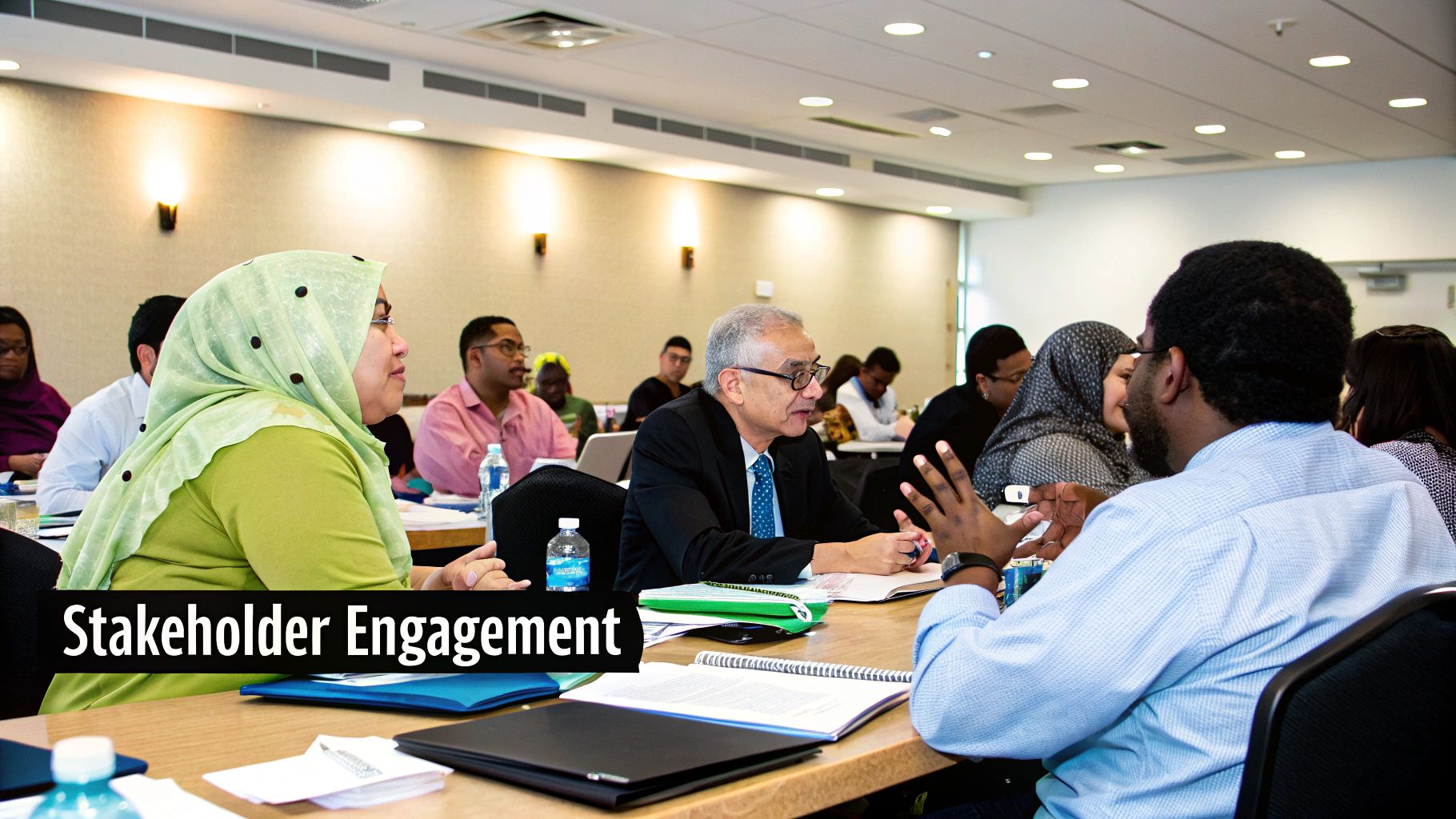Beyond the Checklist: What Really Drives Project Victory?
In today's competitive environment, simply completing a project isn't enough. True success is measured by delivering on time, within budget, and to the specified quality, all while achieving the intended business value and stakeholder satisfaction. But what separates the projects that triumph from those that falter? The answer lies in mastering a set of core principles known as project success factors.
This guide moves beyond generic advice to provide a deep dive into the most critical factors that define project outcomes. Forget vague theories; we will explore actionable strategies, practical examples, and fresh perspectives to help you not just manage, but lead your projects to a decisive win. Understanding and implementing these key project success factors is the most reliable way to turn ambitious goals into tangible results.
We'll dissect the fundamental components that form the bedrock of any successful initiative, from initial scoping to final delivery. This article provides a structured roadmap for small businesses, entrepreneurs, and agencies looking to elevate their project management capabilities. You will learn how to implement these principles to ensure your next project doesn’t just finish, but finishes strong and delivers its promised impact.
1. Clear Project Scope and Requirements Definition
The foundation of any successful project is a crystal-clear understanding of what needs to be achieved. A well-defined project scope and detailed requirements act as the project's constitution, establishing firm boundaries, outlining specific deliverables, and setting measurable objectives. This critical first step ensures that every stakeholder, from the project team to the client, shares a unified vision of the end goal, which is one of the most vital project success factors.

Without this clarity, projects are vulnerable to scope creep, where uncontrolled changes and additions derail timelines and exhaust budgets. Think of the London 2012 Olympics; its success was built upon meticulously detailed specifications for every venue, event, and logistical requirement. This level of definition provided a stable baseline against which all progress was measured and all decisions were made.
How to Implement a Clear Scope
Defining your project scope is a proactive process that requires structured documentation and collaborative agreement. It’s not just about what you will do, but also explicitly stating what you will not do.
- Create a Work Breakdown Structure (WBS): Deconstruct the project's major deliverables into smaller, more manageable components. This granular view helps identify all the work required and prevents tasks from being overlooked.
- Document Assumptions and Constraints: List all assumptions (e.g., "key personnel will be available") and constraints (e.g., "budget cannot exceed $50,000"). This clarifies the operational landscape and highlights potential risks early on.
- Establish a Formal Change Control Process: Change is inevitable, but it must be managed. A formal process ensures that any requested changes to the scope are reviewed, approved, and documented, preventing unauthorized alterations. Exploring effective strategies for managing project scope creep on creativize.net can provide your team with the tools to handle this challenge. This formal procedure is a key differentiator between well-managed projects and those that spiral out of control.
2. Strong Leadership and Project Sponsorship
While a clear scope sets the destination, strong leadership is the engine that drives the project there. This crucial success factor encompasses two key roles: a competent project manager who navigates the day-to-day challenges and an engaged executive sponsor who champions the project at the organizational level. This dual leadership structure provides both tactical guidance and strategic alignment, creating an environment where the project team can thrive and overcome obstacles. A project with weak leadership is like a ship without a captain, adrift and vulnerable to the slightest storm, which is why this is one of the most critical project success factors.

Think of Steve Jobs' relentless drive behind the original iPhone. His leadership wasn't just about vision; it involved making tough decisions, securing resources, and shielding the team from organizational politics. Similarly, Margaret Hamilton's leadership in directing the Apollo software development ensured meticulous quality and reliability, which was vital for the mission's success. This combination of hands-on management and high-level support is the hallmark of projects that deliver exceptional results.
How to Foster Strong Leadership
Cultivating effective leadership is an intentional act that requires careful selection, clear role definition, and consistent engagement. It's about empowering individuals to lead while holding them accountable for the project's ultimate success.
- Select the Right Leaders: Choose a project manager with a proven track record of delivering similar projects and a sponsor who has the influence and commitment to clear organizational roadblocks. Their roles should be distinct but complementary.
- Establish Clear Roles and Responsibilities: Document the specific duties of the project manager (e.g., managing budget, schedule, team) and the sponsor (e.g., championing the project, approving major changes, providing resources). This prevents confusion and power struggles.
- Create Regular Sponsor Review Meetings: Schedule recurring, high-level meetings between the project manager and the sponsor. This ensures the sponsor remains actively engaged, informed of progress and risks, and can intervene when necessary. Understanding how to define organizational leadership that drives measurable success is fundamental to ensuring projects achieve their objectives and deliver lasting value. This structured communication is vital for maintaining strategic alignment throughout the project lifecycle.
3. Effective Stakeholder Engagement and Communication
A project’s success is not just about delivering on time and on budget; it hinges on effectively managing the web of people who have a stake in its outcome. Effective stakeholder engagement involves systematically identifying, analyzing, and communicating with every individual or group impacted by the project. This continuous dialogue ensures expectations are managed, support is secured, and potential conflicts are resolved proactively, making it one of the most critical project success factors.

When stakeholders feel ignored or uninformed, they can become roadblocks, intentionally or not. Consider the extensive community engagement program for London's Crossrail project; by proactively addressing the concerns of local residents and businesses, the project team mitigated significant opposition and maintained public support. This approach transforms stakeholders from potential adversaries into valuable project allies.
How to Implement Effective Engagement
Building strong stakeholder relationships requires a structured, empathetic, and consistent communication strategy. It's about ensuring the right people get the right information at the right time, in a way that resonates with them.
- Develop a Stakeholder Communication Matrix: Map out all stakeholders and define what information they need, how frequently they need it, and through which channel (e.g., weekly email updates for the core team, monthly dashboard reports for executives).
- Tailor Your Message: A one-size-fits-all communication plan is ineffective. Customize your messages based on the stakeholder's level of interest, influence, and technical understanding. An investor needs high-level financial metrics, while an end-user needs updates on feature rollouts.
- Schedule Regular Feedback Sessions: Don't wait for problems to arise. Create formal opportunities for stakeholders to provide input and voice concerns, such as recurring review meetings or surveys. Mastering these techniques is fundamental, and exploring some client communication best practices on creativize.net can provide your team with a robust framework for managing these crucial interactions.
4. Adequate Resource Allocation and Management
Even the most brilliant plan will falter without the necessary fuel to execute it. Proper resource allocation ensures that a project is equipped with the right people, budget, tools, and materials precisely when they are needed. This involves meticulous planning, securing sufficient funding, assembling a team with the right skills, and navigating resource constraints throughout the project lifecycle. Inadequate resourcing is a primary cause of project failure, making its management one of the most crucial project success factors.

Without this foresight, teams face burnout, timelines stretch, and quality suffers. Consider SpaceX's development of the Falcon Heavy rocket; its success was contingent on a highly focused allocation of top engineering talent, advanced materials, and significant capital. This strategic resourcing enabled them to overcome immense technical challenges and achieve a groundbreaking launch.
How to Implement Adequate Resource Management
Effective resource management is a continuous process of planning, monitoring, and adapting. It requires a clear-eyed assessment of what is needed versus what is available, and a strategy to bridge any gaps.
- Identify and Secure Critical Resources Early: Begin by identifying the most critical resources for your project, whether it's specialized software, a subject matter expert, or a specific piece of equipment. Secure commitments for these resources before the project kicks off to avoid delays later.
- Build a Contingency Buffer: No project plan is perfect. Build a contingency of 10-20% into your budget and timeline to absorb unexpected costs or delays. This buffer provides the flexibility needed to handle unforeseen issues without derailing the entire project.
- Monitor Resource Utilization Regularly: Use project management tools to track how resources are being used against the plan. Regular monitoring helps you spot overallocation or underutilization early, allowing you to rebalance workloads and keep the project on track. For a deeper dive, exploring creative resource management on creativize.net can offer advanced techniques for optimizing your team's capacity and tools. This proactive oversight is key to maintaining project momentum.
5. Robust Risk Management and Contingency Planning
A project without a plan for the unexpected is a project waiting to fail. Robust risk management involves proactively identifying, analyzing, and preparing for potential threats before they derail your efforts. It’s a systematic process that turns uncertainty into a manageable variable, ensuring the project remains resilient in the face of challenges. This forward-thinking approach is one of the most crucial project success factors, as it prevents minor issues from escalating into full-blown crises.
Consider the immense logistical challenge of the Tokyo 2020 Olympics, which faced an unprecedented global pandemic. Its success was heavily reliant on extensive contingency planning, allowing organizers to postpone and adapt rather than cancel entirely. Similarly, the proactive Y2K risk mitigation strategies adopted by financial institutions prevented a potential global catastrophe by addressing the software threat years in advance. These examples highlight how anticipating problems is as important as executing planned tasks.
How to Implement Robust Risk Management
Effective risk management is a continuous cycle, not a one-time event. It requires a commitment to vigilance and structured processes from project initiation through to completion. It’s about creating a safety net that protects your budget, timeline, and objectives.
- Develop a Comprehensive Risk Register: This is the central document for all risk-related activities. Use it to log every potential risk, its probability, its potential impact, and its status. This creates a transparent, single source of truth for the entire team.
- Assign Clear Risk Ownership: Accountability is key. Assign a specific "risk owner" to each identified threat. This individual is responsible for monitoring the risk, developing mitigation strategies, and activating contingency plans if the risk materializes.
- Create Both Mitigation and Contingency Plans: Mitigation plans are proactive steps to reduce the likelihood or impact of a risk. Contingency plans are reactive, outlining the exact steps to take if the risk occurs. For example, a mitigation plan for a key team member leaving might be cross-training, while the contingency plan is to have a pre-vetted contractor on standby. Including risk management in your project framework is a powerful way to ensure your project stays on track.
6. Appropriate Project Methodology and Tools
Choosing the right operational framework and the tools to support it is not just a logistical decision; it's a strategic one. The project management methodology dictates how your team plans, executes, and controls work, while the right tools streamline those processes. Selecting a framework that aligns with your project's complexity, team culture, and client expectations is one of the most impactful project success factors, directly influencing efficiency, collaboration, and adaptability.
The wrong methodology can create immense friction. Forcing a rigid, Waterfall approach on a fast-moving software project can stifle innovation, while a loosely structured Agile method may cause chaos in a large-scale construction project requiring strict sequential dependencies. Spotify’s success with its agile scaling model, using "Squads," "Tribes," and "Guilds," demonstrates how a custom-fit methodology can empower teams and drive continuous delivery. This alignment is what separates well-oiled project machines from those that constantly struggle with their own processes.
How to Select and Implement the Right Framework
Choosing your methodology and tools requires a thoughtful assessment of your project's unique DNA. This isn’t a one-size-fits-all choice but a tailored solution that empowers your team to do its best work.
- Assess Project and Team Characteristics: Evaluate factors like scope flexibility, timeline rigidity, and team experience. A project with evolving requirements benefits from an Agile or Scrum approach, while one with fixed deliverables is better suited to Waterfall. For projects involving complex technical integrations, adhering to essential API integration best practices is a key success factor in itself.
- Provide Comprehensive Training: Don't just adopt a new tool or methodology; invest in training your team. A powerful tool is useless if no one knows how to leverage its features. Ensure everyone understands the principles behind the chosen method and the practical use of the software.
- Customize and Evolve: The best methodologies are not rigid doctrines but adaptable frameworks. Feel free to adopt a hybrid model or customize processes to better fit your organization’s culture. Regularly review what’s working and what isn’t, and be prepared to refine your approach. For creative teams, exploring a range of creative project management software options on creativize.net can reveal tools specifically designed for visual collaboration and iterative workflows.
7. Team Competency and Collaboration
A project’s ultimate outcome is inextricably linked to the people responsible for its execution. Assembling a team with the right mix of skills, experience, and personalities is crucial, but true success hinges on their ability to collaborate effectively. A competent and cohesive team acts as the project's engine, driving innovation, solving complex problems, and maintaining momentum. This synergy is one of the most powerful project success factors, turning a group of individuals into a high-performing unit.
Consider Google's extensive "Project Aristotle" research, which found that psychological safety, not just individual talent, was the most critical dynamic in successful teams. This demonstrates that an environment where members feel safe to take risks and be vulnerable is more important than the raw expertise of its members. Similarly, Amazon's "two-pizza rule" ensures teams are small enough to stay agile and communicative, preventing bureaucratic bloat.
How to Foster Team Competency and Collaboration
Building a high-performing team requires deliberate effort in both selection and cultivation. It's about creating an ecosystem where skills are leveraged and teamwork is the default mode of operation. To foster a highly effective and synergistic project environment, explore proven strategies to improve team collaboration.
- Establish a Clear Team Charter: Co-create a document outlining the team’s mission, roles, responsibilities, communication protocols, and decision-making processes. This aligns everyone from the start and serves as a reference point for navigating challenges.
- Invest in Team Formation and Norming: Dedicate time to activities that help team members get to know each other and establish healthy working norms, following models like Bruce Tuckman's stages of team development. This initial investment pays dividends in long-term cohesion.
- Address Conflicts Quickly and Constructively: Disagreements are inevitable, but unresolved conflict is toxic. Implement a clear process for raising and resolving issues constructively, preventing minor disputes from escalating and damaging team morale. For more insights, learning about creative team management strategies can equip leaders with valuable tools to guide their teams.
8. Continuous Monitoring, Control, and Adaptation
A project plan is a roadmap, not a rigid set of commands. The most successful projects are not those that follow the plan perfectly, but those that adapt intelligently when reality deviates from it. Continuous monitoring, control, and adaptation involve the systematic tracking of project performance against the plan, identifying variances early, and making timely, informed adjustments. This proactive oversight ensures that a project remains on course to meet its objectives, even amidst unforeseen challenges, making it one of the most critical project success factors.
Think of NASA's mission control for space flights. They don't just launch a rocket and hope for the best; they monitor thousands of data points in real-time, ready to make split-second adjustments to ensure mission safety and success. Similarly, in business, this constant feedback loop prevents small issues from escalating into project-derailing crises by fostering a culture of responsiveness and continuous improvement.
How to Implement Continuous Monitoring and Adaptation
Implementing a robust monitoring system requires establishing clear metrics and a disciplined review cadence. It's about creating a living project management process that breathes and reacts to new information.
- Establish Key Performance Indicators (KPIs): At the project's outset, define specific, measurable indicators for tracking progress, such as budget variance, schedule performance index (SPI), and task completion rates. These KPIs provide objective data for decision-making.
- Utilize Project Management Dashboards: Employ tools that offer real-time visibility into project health. Dashboards consolidate data from various sources into an easily digestible visual format, allowing managers to spot trends and potential issues at a glance.
- Implement a Regular Review Cadence: Schedule consistent checkpoint meetings (e.g., weekly status reviews, agile sprint retrospectives) with the team and key stakeholders. These forums are essential for discussing progress, addressing roadblocks, and formally agreeing on any necessary adaptations to the project plan. This creates a powerful feedback loop for ongoing optimization.
Key Factors Comparison for Project Success
| Aspect | Clear Project Scope and Requirements Definition | Strong Leadership and Project Sponsorship | Effective Stakeholder Engagement and Communication | Adequate Resource Allocation and Management | Robust Risk Management and Contingency Planning | Appropriate Project Methodology and Tools | Team Competency and Collaboration | Continuous Monitoring, Control, and Adaptation |
|---|---|---|---|---|---|---|---|---|
| Implementation Complexity 🔄 | Medium – detailed documentation and stakeholder involvement | High – depends on skilled individuals and active sponsors | Medium-High – ongoing communication, managing diverse needs | High – complex planning, forecasting, and management | High – continuous risk analysis and mitigation planning | Medium-High – choosing and integrating methodologies/tools | Medium – team building and ongoing development | Medium – requires discipline and consistent data tracking |
| Resource Requirements ⚡ | Moderate – time and effort upfront for scope definition | Moderate – skilled leaders and sponsors needed | Moderate-High – communication channels and feedback systems | High – skilled people, budget, tools, and contingencies | Moderate – expertise and dedicated risk monitoring resources | Moderate – software, training, and process customization | Moderate – training, collaboration activities, skilled staff | Moderate – monitoring tools, review meetings, and reporting |
| Expected Outcomes 📊 | Clear objectives, reduced scope creep, accurate estimates | Strong vision, quick decisions, motivated teams | Enhanced trust, stakeholder alignment, smoother execution | Efficient execution, reduced delays, higher quality | Reduced failures, proactive issue resolution, increased confidence | Structured processes, improved productivity, team alignment | Higher quality deliverables, innovation, strong morale | Early problem detection, proactive control, continuous improvement |
| Ideal Use Cases 💡 | Projects needing precise boundaries and measurable success | Complex projects requiring strong direction and sponsor support | Projects with many or diverse stakeholders | Resource-intensive projects with complicated resource needs | Projects with high uncertainty and potential risks | Projects needing methodology alignment and tool integration | Projects relying on skilled teamwork and collaboration | Projects needing tight control and adaptability |
| Key Advantages ⭐ | Prevents ambiguity and scope creep, facilitates stakeholder alignment | Provides direction and motivation, enables quick decisions | Builds trust, increases buy-in, prevents misunderstandings | Improves productivity, reduces bottlenecks, enhances flexibility | Prevents crises, improves decision-making, builds confidence | Consistency, efficiency, collaboration, knowledge retention | Improves problem-solving, morale, creativity, knowledge sharing | Maintains alignment, enables timely corrections, fosters improvement |
Integrating These Factors for Guaranteed Success
Navigating the complex landscape of project management can often feel like assembling an intricate puzzle. We have explored the eight fundamental project success factors, from establishing a crystal-clear project scope to fostering continuous monitoring and adaptation. Each element, whether it's strong leadership, effective stakeholder communication, or robust risk management, represents a critical piece of that puzzle. However, true mastery lies not in just possessing these pieces, but in understanding how they interconnect to form a cohesive, powerful whole.
Think of these factors not as a checklist to be ticked off, but as an integrated system. Strong leadership, for instance, directly empowers the team, ensuring they have the support needed to collaborate effectively. A well-defined scope makes resource allocation more precise and transparent, preventing budget overruns and schedule delays. Similarly, robust monitoring and control mechanisms are only as effective as the project methodology and tools you choose to implement them. When these elements work in concert, they create a powerful synergy that transforms your project from a series of tasks into a value-generating engine.
From Theory to Actionable Strategy
The ultimate takeaway is that these principles are not abstract theories. They are actionable strategies that require conscious effort and consistent application. The journey to project excellence is an iterative one, built on the foundation of learning and continuous improvement. Your next steps should involve a practical application of these insights to your current and future endeavors.
To begin this process, consider these immediate actions:
- Conduct a Project Post-Mortem: Using these eight factors as a framework, review your most recently completed project. Where did you excel? Which factors were underdeveloped? Identifying these patterns is the first step toward building a more resilient process.
- Create a Pre-Project Checklist: Before your next project kicks off, develop a checklist based on these success factors. Ask the critical questions: Is our sponsorship clear and engaged? Have we identified all key stakeholders? Is our risk log comprehensive? This proactive approach sets the stage for success from day one.
- Champion a Culture of Collaboration: True success is a team sport. Focus on strengthening the seventh factor, Team Competency and Collaboration, by investing in communication tools, defining clear roles, and celebrating collective wins. A cohesive team can more easily adapt to challenges and innovate on the fly.
By weaving these core project success factors into the very fabric of your organization's project management DNA, you move beyond simply completing projects. You begin to deliver them with predictable excellence, consistently achieving desired outcomes, maximizing ROI, and building a reputation for reliability and success. This proactive, integrated approach is what separates struggling projects from those that truly thrive and drive meaningful business growth.
Executing these factors often requires specialized talent and a competent, collaborative team. If you're looking to build a team with the right skills to ensure your project's success, Creativize connects you with a curated community of professional freelancers. Find the expert partners you need to bring your vision to life and turn your project goals into reality at Creativize.

